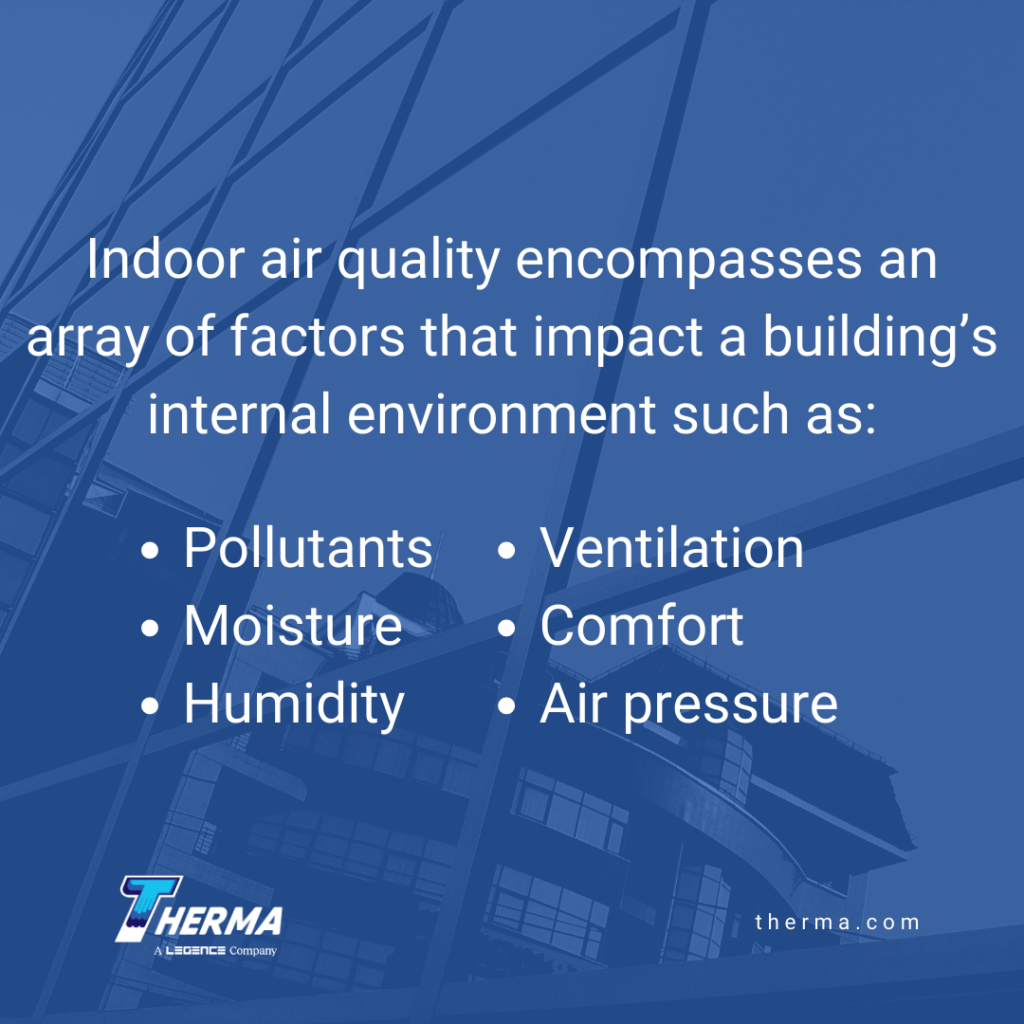by Patti Dees
Improving office building indoor air quality (IAQ) benefits employee health, and can help a company’s bottom line through reduced absenteeism and improved performance. Healthier workspaces require more than changing HVAC filters regularly. IAQ maintenance requires the development of a plan and long-term commitment to see it through.
Importance of indoor air quality
According to the EPA, most Americans are indoors 90% of the time. As the COVID-19 pandemic illustrated, facilities need to recognize and actively develop IAQ plans to ensure indoor spaces are healthy and comfortable.
Indoor air quality encompasses an array of factors that impact a building’s internal environment such as pollutants, moisture and humidity, ventilation, comfort, and air pressure. Poor air quality results in a range of events from nuisance situations to long-term health issues, depending on the source and how it is handled. Studies conducted by the Harvard T.H. Chan School of Public Health have shown that air quality affects productivity, decision-making, and response time.
Pollutants: the Main Villain
There are three types of pollutants: biological, chemical, and particulate. Viruses and mold are examples of biological pollutants. Pesticides and cleaners contribute to indoor chemical pollution. And allergens such as pollen, smoke, and dust can aggravate allergies and asthma. Pollutants create literal headaches or worse for occupants.
Two pollutants that are difficult to recognize but have serious consequences are radon and carbon monoxide. Exposure to high levels of radon has been linked to lung cancer. Carbon monoxide poisoning reduces the amount of oxygen in the body and leads to seizures or suffocation.
Tips
- Identify the source and remove it if possible. For sources that cannot be eliminated: isolate the source, ventilate occupied areas to dilute the concentration of the pollution, and use filters to clean the air.
- Take precautions and follow instructions carefully when using pesticides and chemical cleaning products.
- Control smoke and dust levels by discouraging smoking, and placing barriers to reduce dust from maintenance or construction activities.
- Use proactive HVAC maintenance practices and consider the use of UV-C lights to combat microbes in the ventilation system.
- Install radon and carbon monoxide detectors.
Moist: More Than an Uncomfortable Word
Often overlooked, moist humid air can exacerbate the impact of pollutants such as mold and the transmission of some viruses. But humidity can create hazards of its own. Low relative humidity dries out eyes and sinuses causing, at the very least, discomfort. High humidity, on the other hand, can lead to excess moisture in the form of condensation. This may create hazardous situations depending on the amount and location of the excess moisture that can damage building materials, fixtures, and equipment. Optimal IAQ should seek to balance humidity throughout the building.

Tips
- Common sources of moisture and humidity are HVAC or plumbing issues and poorly sealed ducts or buildings.
- Inspect drains and plumbing for overflow or damage.
- Ensure ventilation and air conditioning ducts are sealed and insulated.
- Identify and repair any openings in the building envelope that are not properly sealed, especially in humid regions.
- If necessary, and feasible, invest in humidifiers or dehumidifiers as needed.
- Maintain plants properly to avoid adding to a moisture problem in the office.
Comfort: We Only Want It When It’s Gone
Comfort is an undersold aspect of IAQ. Rather than a distraction, sources of discomfort indicate probable or future issues. Odors from garbage or hidden mold signal that conditions are right for microbial growth and moisture damage. Airflow patterns do more than distribute warm or cool air; they dilute contaminants. The position of furniture and equipment can impede air flow or create difficult-to-clean areas.
Tips
- Clean surfaces and dispose of garbage frequently.
- Avoid blocking vents and drains.
- Preventive maintenance (PM) activities provide a slew of benefits. PM helps prevent sources of hidden mold and issues with air handling units or ducts that cause high-velocity airflow in some spaces and stale air in others.
Putting Together a Comprehensive Air Quality Management Plan
The first phase of creating a plan of any kind starts with three questions: what are the goals, what is currently in place, and what is needed?
For IAQ, the goals should be quantifiable and measurable. Rather than “clean air”, set benchmarks or use established certification or code standards. For example, set a goal of relative humidity between 40 and 60%, not “comfortable moisture levels”.
Next, take stock of both current sources of poor IAQ and any areas that experience good IAQ. Note and address known issues, but also recognize practices or equipment that are already working to meet benchmarks. Catalog equipment available on site for measuring or tracking IAQ data.
Finally, with expectations set and a solid grasp of the current state of air quality in the office, a plan can be developed to close any gaps. Purchasing missing equipment and setting policies to support cleanliness is just the beginning. Part of managing IAQ is to include it in current and future decision-making processes. Improving or maintaining healthy air quality requires a long-term commitment.
Creating a healthy building may seem like a major challenge. Share your goals with the knowledgeable professionals at Therma and they can guide you through the process from design to maintenance.
Patti draws on her background as a chemical engineer to share information with readers on technology, manufacturing, and construction.
Sources and Additional Reading
EPA.gov – An Office Building Occupants Guide to Indoor Air Quality | US EPA
Kaiterra.com – Office Air Quality: How to Measure, Improve, and Communicate
Harvard Business Review – Research: Stale Office Air Is Making You Less Productive
Facility Executive – Want To Make Facilities Safe For Employees’ Return To The Office? Improve IAQ.
Facility Executive – Cost-Effective Strategies for Improving IAQ
EPA.gov – Appendix A: Common IAQ Measurements – A General Guide







